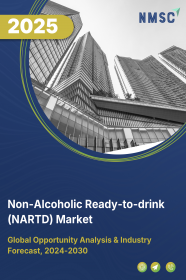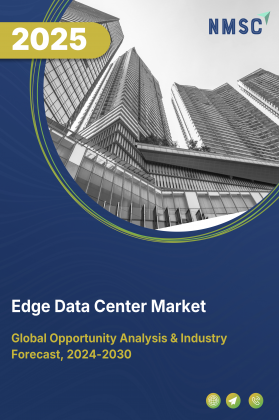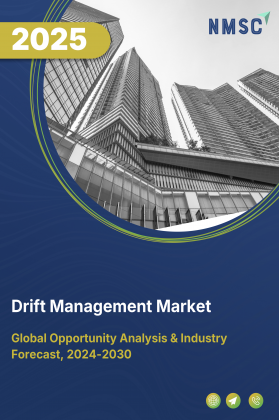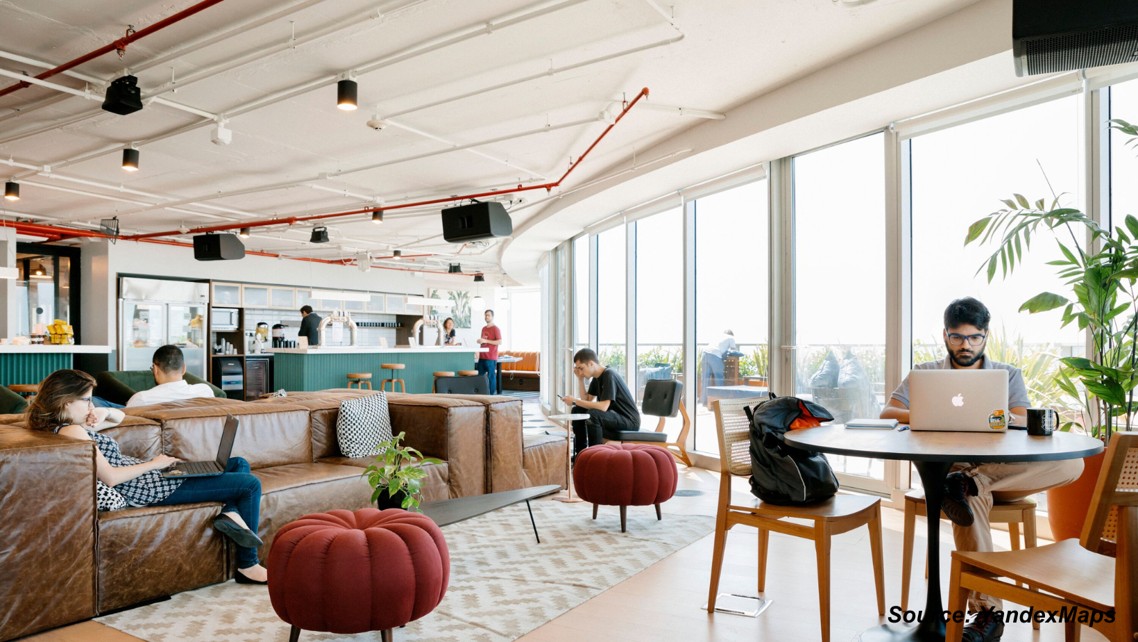
Non-Alcoholic Ready-to-drink (NARTD) Market by Type (Carbonated Soft Drinks, RTD Coffee & Tea, Bottled Water, Juices, Functional Beverages, Dairy-based Beverages, Plant-based Beverages and Others), by Packaging (Bottles, Cans, Tetra Packs/Cartons, Pouches/Sachets and Others), by Distribution Channel (Retail (B2C), Foodservice (HoReCa), and B2B/Wholesale) – Global Opportunity Analysis and Industry Forecast 2023-2030
Market Definition
The global Non-Alcoholic Ready-to-drink (NARTD) Market size was valued at USD 894.10 billion in 2022 and is predicted to reach USD 1321 billion by 2030 with a CAGR of 5% from 2023-2030. Non-Alcoholic Ready-to-Drink (NARTD), also known as non-alcoholic beverages that are pre-packaged, alcohol-free drinks ready for immediate consumption. They come in various forms, including carbonated soft drinks, flavored water, fruit juices, energy drinks, sports beverages, dairy alternatives and iced tea, and coffee.
NARTD products are known for their convenience and appeal to a broad consumer base, offering options for refreshment, hydration, and caffeine intake. These drinks are widely available in cans, bottles, and other packaging formats at supermarkets, convenience stores, and vending machines.
Market Dynamics and Trends
The market has witnessed significant growth in recent times due to increasing number of health-conscious people and company’s effort to cater to the changing consumer preferences by offering diverse flavors, low-sugar options, and eco-friendly packaging. For instance, in August 2023, with the launch of Pepsi Zero Sugar in the U.S., the company took a step towards maintaining the health awareness among the consumers. Also, the packaging is done using 100% recyclable materials to support the sustainable way of living.
According to the recent data published by International Wine & Spirit Research, non-alcoholic beverages are expected to become 27.6% more popular among 21- to 25-year-olds. A significant consumer shift towards low-sugar alternatives in non-alcoholic ready-to-eat and energy drinks which align with their dietary goals and well-being is contributing towards the growth of the NARTD market. Major players are quick to realize this shift and are leaving no stone unturned to seize this opportunity.
Increasing availability of non-alcoholic beverages on online platforms is another factor boosting the overall market growth. As e-commerce expands, consumers can now conveniently access a wide variety of NARTD products from home. Recently, ReserveBar launched a new e-commerce website to expand its consumer reach into the canned drinks sector and make it easier for people to get cold canned drinks delivered to their doors. The website offers fast delivery of canned seltzers, non-alcoholic cocktails, and other ready-to-drink (RTD) beverages.
Moreover, the non-alcoholic ready-to-eat drinks industry is growing owing to its easy availability through vending machines in places including universities & colleges and other commercial areas. Coca-Cola’s partnership with the University of Arkansas to become its exclusive non-alcoholic cold beverage sponsor for providing its products in campus dining facilities and vending machines shows an impactful growth strategy in this industry.
However, strict regulations on labeling, health claims, and ingredients are hindering the growth of the non-alcoholic ready-to-drink (NARTD) market. On the contrary, introduction of eco-friendly packaging options, such as recyclable and biodegradable materials, immensely reduces the environmental impact of the NARTD industry, creating significant market opportunities in the coming years. For instance, in June 2023, SAYSO, the world's first craft cocktail tea bags, launched a new sustainable packaging with two new flavors. This innovative packaging, with sustainable materials is expected to reduce the environmental impact of the non-alcoholic beverage industry.
Market Segmentation and Scope of Study
The non-alcoholic ready-to-drink (NARTD) market share is segmented on the basis of type, packaging, distribution channel, and region. On the basis of type, the market is categorized into carbonated soft drinks, RTD coffee & tea, bottled water, juices, functional beverages which comprises of sports and energy drinks and nutraceutical / vitamin-fortified drinks, dairy-based beverages, plant-based beverages and others. On the basis of packaging, the market is classified into bottles which comprises of PET and glass, cans, tetra packs/cartons, pouches/sachets and others .
On the basis of distribution channel, the market is bifurcated into Retail (B2C) which comprises of convenience stores, specialty/health-food stores, online retail and D2C websites, vending machines, Foodservice (HoReCa) which comprises of hotels and resorts and institutional canteens, and B2B/Wholesale which comprises of corporate and event supply and catering and institutional contracts. Regional breakdown and analysis of each of the aforesaid segments includes regions comprising of North America, Europe, Asia-Pacific, and Rest of World (RoW).
Geographical Analysis
North America holds the dominating share of the non-alcoholic ready-to-drink (NARTD) market at present and is expected to continue its dominance throughout the forecast period. This is attributed to factors such as growing number of bars and restaurants offering drinks including non-alcoholic cocktails, mocktails, and beers in developed countries such as the U.S. and Canada. According to the recent survey conducted by NCSolutions shows that one out of three Americans consciously tries to consume less alcohol, and there is a growing interest among them towards non-alcoholic drinks. The survey also found that 45% of respondents are interested in going to a sober bar where only mocktails are served.
In addition, growing demand for non-alcoholic beverages in the aviation industry to offer refreshment to the boarding passengers is propelling the non-alcoholic ready-to-drink market growth in developed nations such as the U.S. and Canada. For instance, in May 2023, Athletic Brewing Company and JetBlue partnered to offer non-alcoholic beer on domestic flights, making JetBlue the first major U.S. airline to serve non-alcoholic beer in the skies. The partnership is a huge milestone for Athletic Brewing and a key partnership for them in the travel industry.
On the other hand, Asia-Pacific is considered fastest growing region in the non-alcoholic beverages industry owing to the increasing urbanization which led to a fast-paced lifestyle favorable to non-alcoholic drinks. In early 2022, Carlsberg started selling two alcohol-free beers in Singapore, under the Carlsberg brand name which is the company's first step in building up its alcohol-free beer portfolio in Asia. It also launched an alcohol-free version of its Chongqing Beer in China and aims to double its sales of alcohol-free beers.
Furthermore, the leading companies are adopting various business strategies including product launch and business expansion, which in turn is boosting the non-alcoholic ready-to-drink (NARTD) market growth. For instance, in November 2022, Asahi Group Holdings launched Asahi Super Dry 0.0%, an alcohol-free alternative to Japan's top-selling and first super-dry beer, worldwide. Through this, the company aims to offer a new option for people who want to reduce their alcohol intake while still enjoying a great-tasting beer. The launch is part of Asahi Group's strategy to boost sales of its global premium brand, Asahi Super Dry.
Competitive Landscape
The non-alcoholic ready-to-drink (NARTD) industry is highly competitive and include several market players such as Suntory Beverage & Food Ltd, Nestle S.A., The Coca‑Cola Company, Keurig Dr Pepper Inc., Kraft‑Heinz, Inc., Asahi Group Holdings, Ltd., Unilever, Red Bull GmbH, Parle Agro Pvt. Ltd., Del Monte Foods, Inc., Rauch Fruchtsäfte GmbH & Co OG, PepsiCo, Inc., Danone S.A., Britvic Plc, Refresco Group and others.
These market players are opting various strategies such as new product launches and acquisition to maintain their dominance in the global non-alcoholic ready-to-drink (NARTD) market. For instance, in July 2023, Monster Energy Company acquired Bang Energy's assets, including a beverage production facility to provide Monster with opportunities for all of its brands. The acquisition is expected to provide several options to create value, including repositioning and repackaging to better target the fitness and performance energy drinks segment.
Moreover, in October 2022, Nestle acquired Seattle's best coffee brand from Starbucks as part of its focus on driving sustained profitable growth in the coffee market. The acquisition adds depth to Nestle's North American coffee portfolio, where it currently distributes Starbucks, Nescafé, Nespresso, and Blue Bottle Coffee packaged products. It distributes Starbucks consumer products and foodservice beverages across more than 80 markets outside Starbucks retail stores under the Global Coffee Alliance.
Key Benefits
-
The report provides quantitative analysis and estimations of the non-alcoholic ready-to-drink (NARTD) market from 2023 to 2030, which assists in identifying the prevailing market opportunities.
-
The study comprises a deep-dive analysis of the current and future non-alcoholic ready-to-drink (NARTD) market trends, depicting the prevalent investment pockets in the industry.
-
Information related to key drivers, restraints, and opportunities and their impact on the non-alcoholic ready-to-drink (NARTD) market is provided in the report.
-
Competitive analysis of the key players, along with their market share is provided in the report.
-
SWOT analysis and a Porter's Five Forces model is elaborated on in the study.
-
Value chain analysis in the market study provides a clear picture of the roles of the stakeholders.
Non-Alcoholic Ready-To-Drink Market Key Segments
By Type
-
Carbonated Soft Drinks
-
RTD Coffee & Tea
-
Bottled Water
-
Juices
-
Functional Beverages
-
Sports & Energy Drinks
-
Nutraceutical / Vitamin‑fortified Drinks
-
-
Dairy‑based Beverages
-
Plant‑based Beverages
-
Others
By Packaging
-
Bottles
-
PET
-
Glass
-
-
Cans
-
Tetra Packs/Cartons
-
Pouches / Sachets
-
Others
By Distribution Channel
-
Retail (B2C)
-
Convenience Stores
-
Specialty / Health‑food Stores
-
Online Retail & D2C Websites
-
Vending Machines
-
-
Foodservice (HoReCa)
-
Hotels & Resorts
-
Institutional Canteens
-
-
B2B / Wholesale
-
Corporate & Event Supply
-
Catering & Institutional Contracts
-
By Region
-
North America
-
The U.S.
-
Canada
-
Mexico
-
-
Europe
-
The UK
-
Germany
-
France
-
Italy
-
Spain
-
Denmark
-
Netherlands
-
Finland
-
Sweden
-
Norway
-
Russia
-
Rest of Europe
-
-
Asia Pacific
-
China
-
Japan
-
India
-
South Korea
-
Australia
-
Indonesia
-
Singapore
-
Taiwan
-
Thailand
-
Rest of Asia Pacific
-
-
RoW
-
Latin America
-
Middle East
-
Africa
-
Key Players
-
Suntory Beverage & Food Ltd
-
Nestle S.A.
-
The Coca‑Cola Company
-
Keurig Dr Pepper Inc.
-
Kraft‑Heinz, Inc.
-
Asahi Group Holdings, Ltd.
-
Unilever
-
Red Bull GmbH
-
Parle Agro Pvt. Ltd.
-
Del Monte Foods, Inc.
-
Rauch Fruchtsäfte GmbH & Co OG
-
PepsiCo, Inc.
-
Danone S.A.
-
Britvic Plc
-
Refresco Group
REPORT SCOPE AND SEGMENTATION:
|
Parameters |
Details |
|
Market Size in 2022 |
USD 894.10 Billion |
|
Revenue Forecast in 2030 |
USD 1321 Billion |
|
Growth Rate |
CAGR of 5% from 2023 to 2030 |
|
Analysis Period |
2022–2030 |
|
Base Year Considered |
2022 |
|
Forecast Period |
2023–2030 |
|
Market Size Estimation |
Billion (USD) |
|
Growth Factors |
Health-consciousness among consumers with preferences towards low-sugar options and sustainable packaging. Increasing availability of non-alcoholic beverages on online platforms. Rising availability and acceptance of non-alcoholic beverages among the colleges and universities in dining areas and vending machines. |
|
Countries Covered |
28 |
|
Companies Profiled |
10 |
|
Market Share |
Available for 10 companies |
|
Customization Scope |
Free customization (equivalent to up to 80 working hours of analysts) after purchase. Addition or alteration to country, regional, and segment scope. |
|
Pricing and Purchase Options |
Avail customized purchase options to meet your exact research needs. |




















 Speak to Our Analyst
Speak to Our Analyst

























